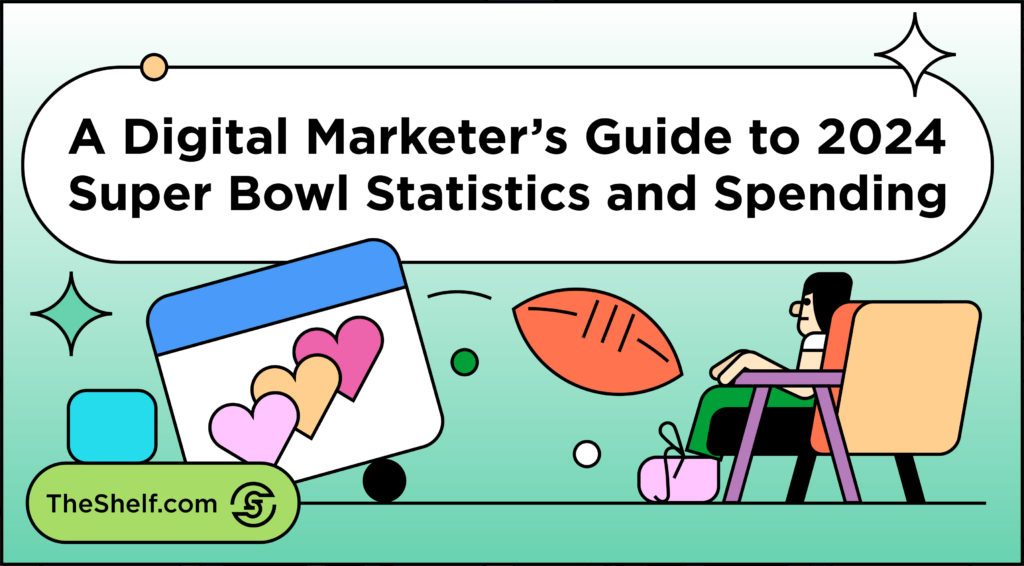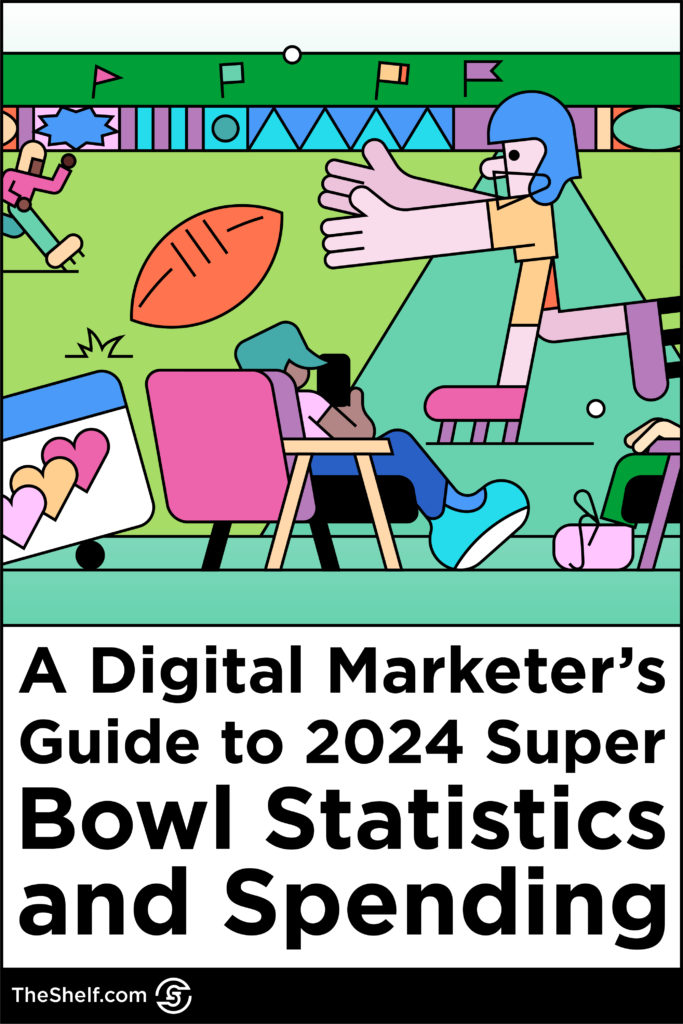It’s that time of year again, the stretch of winter after the New Year without holidays in sight. What do we have to look forward to — Groundhog Day? Not after all those time-loop movies. No thanks. It turns out, many Americans are looking toward an unofficial holiday — Super Bowl Sunday — for their next big celebration. Bring on the game-day snacks and influencer marketing strategy! There will be plenty of Super Bowl spending to go around.
Let’s break down all the stats you need to know before it’s Sunday Sunday Sunday!

The Game of Games 2024
Super Bowl LVIII will take place on Sunday, February 11 at Allegiant Stadium in Las Vegas, Nevada (home of the Raiders). This will be the first time in history Las Vegas hosts a Super Bowl game.
In 2021, the NFL voted to adopt a new 17-game schedule, adding one additional game to the regular season. This pushed the Super Bowl back from the first weekend in February to the second and somewhat altered our marketing calendars. Happy almost Valentine’s Day to football fans!
Fun fact: the change in NFL schedule the past few years also included changes to the process of competing in international games. According to NBC Sports, NFL teams will now be required to play at least one international game every eight years. In the coming years, maybe these roundups will include international statistics, too!
SUPER BOWL LVIII PREDICTIONS
As of this writing (Week 18 of the NFL 2023 season), Bleacher Report has named the Baltimore Ravens and San Francisco 49ers the most likely teams to face off in Super Bowl 58. However, the Los Angeles Rams could also have a shot as San Francisco’s top divisional rival.
It’s too bad the Kansas City Chiefs aren’t a top pick. We all could have capitalized on the Swiftie market crossover the way the NFL has this season. Of course, anything could happen in the playoffs, which begin this Saturday, January 13. We’ll just have to wait and see who will take center stage at this year’s big game.
Whether you’re a fan of the Ravens, 49ers, or the blossoming love of Trav and Tay, there’s a little something for everyone on Super Bowl Sunday. Sports lovers and party-goers alike can enjoy the fanfare of the big game. Not to mention all the game-day snacks, decorations, and apparel. Plus, all the creative commercials and, of course, the halftime show.
FOR THE LOVE OF SUPER BOWL COMMERCIALS

The Super Bowl has long been home to some of the greatest advertising of the year. Some have gone as far as calling it the Commercial Bowl, and it’s hard to disagree. According to AdAge, CBS is charging as much as $7M for a 30-second commercial slot during the 2024 Super Bowl.
These ad slots are so coveted that CBS was nearly sold out of commercial spots before the regular NFL season even began. If preparation is any indication of quality (and we tend to think it is), these should be some of the best Super Bowl commercials we’ve ever seen.
It’s no secret that traditional media companies are seeing a decline in advertising these days. Airing the game is an advertising extra point for Paramount Global and CBS this year. In 2023, Fox raked in more than $600M in advertising revenue for the game. And it seems as if the big-money advertising trend will continue.
THE SUPER BOWL HALFTIME SHOW PRESENTED BY APPLE MUSIC
Of course, if you’re not into the first downs or the commercial breaks, there’s always the halftime show. The 2024 Super Bowl Halftime Show presented by Apple Music will feature the one, the only, Usher.
Even if your target audience isn’t particularly interested in football, chances are they’ll enjoy this iconic performer. Usher may invite a few special guests to join him on stage, but any additional performers have yet to be announced. So we may be in for a few surprises! Either way, it’s sure to be a good show.
SUPER BOWL STATISTICS ON TICKET HOLDERS
It’s Nevada’s first time hosting a Super Bowl, and they’re doing it in style. Allegiant Stadium opened in 2020 to house the Raiders as they moved from Oakland to Las Vegas. Unfortunately, the Raiders are out of playoff contention, so there’s no chance of a home-field advantage for 2024’s big game.
Most of the seats are already sold out, with resellers like Ticketmaster selling nosebleed seats for upwards of $10,000. The 65,000-seat Allegiant Stadium is expected to be at full capacity on Super Bowl Sunday. Fans should not expect any temporary seating to be added to the stadium as in previous years.
If you were lucky enough to snag a seat before they sold out, you’d be shelling out a pretty penny to watch the game IRL. At the time of writing, ticket prices listed on Vivid Seats started at $5,809 for upper-level seats and ranged all the way to $31,883 for Club Premium seating.
ECONOMIC IMPACT
Super Bowl weekend is the second biggest weekend of the year in Las Vegas, next to New Years Eve, even when they aren’t hosting the game. An average 300,000 people celebrate the Super Bowl in Las Vegas in any given year. This year, that number is expected to jump to 450,000, as an estimated 125,000 to 150,000 will travel in for the game itself. According to the Las Vegas Super Bowl Committee, accommodating that many people will take an important balance.
The Super Bowl is a lucrative weekend for Vegas every year, but hosting adds even more big bucks. Super Bowl 58 is expected to bring in anywhere from $500M to $1B for the city.
If you’re a small business located in Las Vegas, this could be good news for you and your upcoming influencer marketing campaign. Our advice? Go local. Target tourists. Capitalize on the gameday fanfare.
Projections aside, it will be interesting to see how Super Bowl 58 shakes out on the field and in our marketing efforts. Perhaps we can learn a bit about the future from our past. Below we’ve compiled some of the most telling stats from last year’s game.
Recap: Battle of the Pigskin 2023
Super Bowl 57 did some major numbers. In fact, it was the most-watched telecast of all time, with 115.1 million viewers. (In case you missed it, the Kansas City Chiefs came back to beat the Philadelphia Eagles 38 – 35 in what must be the most historic day in Kelce family history.)
The 115.1 million viewers include those who tuned in across Fox, Fox Deportes, and digital streaming services. It surpassed the previous record holder for Super Bowl viewership, the 2015 showdown in which the New England Patriots battled the Seattle Seahawks.
The spike in viewership is likely due to the hype surrounding the Kelce brothers, the impressive comeback during the game, and a general return to normalcy after several years of Covid protocols put a damper on game-day celebrations.
According to the National Retail Federation, 103.5 million people planned to throw or attend a Super Bowl Party last year. And 17.8 million were headed to bars or restaurants to watch the big game.
The breakdown of viewers’ game day priorities broke down as follows: 42 percent were most interested in the game. 19 percent tuned in for the commercials. And 18 percent watched primarily for the halftime show.
A SUCCESSFUL MARKETING CAMPAIGN
One thing about Super Bowl parties: folks are going to make their guac and eat it too. Avocados From Mexico capitalizes on how Super Bowl fans enjoy the delicious game-day treat year after year. Influencers tag the brand on their own guac creations, generating buzz for their recipes and Avocados from Mexico.
Word to the wise: If you come up with a timeless influencer marketing strategy for the Super Bowl this year, you may be able to replicate it for years to come. Evergreen ideas, like guac on game day, never get old.
This campaign proves there are many ways to guac. Don’t underestimate the power of influencer imagination and UGC in your Super Bowl marketing campaign. Fans get creative for game day, and that can be great for your brand.
Find influencers and campaign strategies with longevity and your influencer marketing strategy could become as timeless as game day guac made with Avocados from Mexico.
CONSUMER SPENDING
Spectators spent an average $85.36 per person on Super Bowl-related purchases including food, drink, decorations, and apparel. That totaled to a whopping $16.5 billion in consumer Super Bowl spending. It’s no surprise that food and drink take the cake for the most popular purchases, accounting for 79 percent of Super Bowl spending.
- Food and Beverage: 79 percent
- Team Apparel and Merchandise: 12 percent
- TVs: 10 percent
- Decorations: 7 percent
- Furniture: 7 percent
One thing remains true year after year, fans want to eat while they watch. We expect the food and beverage numbers to stay fairly consistent in 2024. So if you’re marketing eats or drinks, now’s your time to shine!
Not in the food or beverage game? More of a home goods market? Don’t fret. Believe it or not, one of the best times to purchase a new TV or piece of furniture is Super Bowl season. Shoppers can expect to get anywhere from 20 to 50 percent off the regular price of a state-of-the-art TV right around Super Bowl Sunday. And furniture goes on sale too, as furniture retailers liquidate their old inventory to make room for new models.
The Fourth Down on Super Bowl Marketing
The Super Bowl is one of the biggest events on television, for good reason. It gets more views than almost any other programming and moves nearly $14 billion. There are nearly as many women watching the Super Bowl as there are men (46 percent and 54 percent, respectively). And companies that buy TV ad spots during the Super Bowl spend millions of dollars on celebrity appearances, development, production, and promoting the spot before it airs on the big day.
There is plenty of money spent and plenty of money to be made if you have the right influencer marketing strategy. If you need help crafting a winning strategy, let us know. Schedule a strategy call today. We’ve built thousands of successful influencer campaigns, and we’d love for you to become our next success story.

About This Author
Ariana Newhouse | B2B Writer
I am a freelance writer and comedian based in Los Angeles. While making people laugh is my jam, it’s not always the company brand. So, I strive to make people feel something. My writing philosophy is collaborative, empathetic, and humanistic. At the end of the day, no matter the message, there are real people on both ends of the process.



